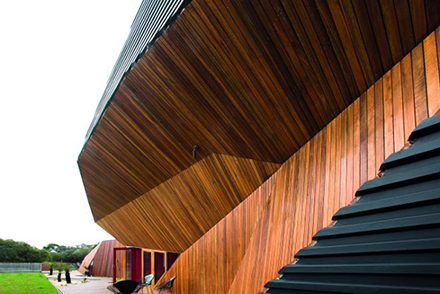
A decision deeming that timber cladding is acceptable for all classes of buildings other than Class 2 and 3 low-rise buildings is to be challenged by the Wood Cladding and External Fixtures Alliance. Source: Timberbiz
The Alliance is pleased the Australian Building Codes Board has confirmed timber cladding is acceptable for all classes of buildings other than Class 2 and 3 low-rise buildings under the existing ‘Deemed-to-Satisfy’ provisions of the National Construction Code.
However, the Alliance said that unfortunately the ABCB had decided that timber cladding is not acceptable for Class 2 and 3 buildings because it is classed as combustible and therefore caught up in blanket ban of all combustible cladding for these classes of buildings.
It believes the new position adopted by the ABCB flies in the face of 20 years of decisions made by building surveyors and certifiers who have interpreted the Code to allow timber cladding to be used on these low-rise buildings.
However, after discussion with the ABCB, the Alliance believes that the primary objective now is to ensure the building industry is aware that timber cladding meets the existing regulations and Deemed-to-Satisfy provisions of other low-rise classes of buildings (typically one or two-storey) in an effort to minimise the loss of up to 2000 jobs and $750 million of value add in the timber products supply chain, almost exclusively in regional Australia.
The Alliance will now focus on initiatives to ensure timber cladding, which is one of the most environmentally and sustainable cladding products, remains a viable alternative for owners of Class 2 and 3 buildings who prefer the aesthetic qualities of timber
It plans to:
- Approach key Building Ministers who ratified the decision at last week’s Building Ministers’ Forum to see if they are prepared to issue a Ministerial Order distinguishing timber from other combustible cladding to allow the immediate use of timber cladding in each Australian State and Territory
- Consider the options in relation to the Out-of-Cycle Amendment process that the ABCB will run
- Look at generic performance solutions, including CodeMark, for certain products
- Conduct further flame spread research on timber cladding in preparation for a Proposal for Change to the National Construction Code in 2022.
Alliance chairman Paul Michael said there was a general view that the impact on timber cladding from a blanket ban on all combustible cladding is an unintended consequence of the recent fires that have involved the more flammable Aluminium Composite Panels and Expanded Polystyrene.
“We have not spoken to one Minister or ABCB member who believes that timber cladding poses a safety threat to the occupants of a building and no risk assessment has been done to demonstrate there is an unacceptable danger,” Mr Michael said.
“The Alliance believes it would have been more appropriate for the ABCB to focus on the issue of fire safety and stipulate certain performance standards which would have excluded the use of highly combustible cladding but continued to allow timber and other suitable well proven products that have significant environmental and aesthetic benefits,’’ he said.
“However, the Board chose not to do this, although we understand there was significant debate about the best option.
“As a result of the ABCB decision, it is absolutely critical all prospective owners, builders, building surveyors and certifiers understand that timber cladding can be used on all Class 1 buildings (houses) and other low-rise building Classes except three-storey Class 2 and 3 buildings. In addition, we now understand we will need to find different pathways for Class 2 and 3 buildings.”
The Alliance will now focus on initiatives to ensure timber cladding, which is one of the most environmentally and sustainable cladding products, remains a viable alternative for owners of Class 2 and 3 buildings who prefer the aesthetic qualities of timber
It plans to:
- Approach key Building Ministers who ratified the decision at last week’s Building Ministers’ Forum to see if they are prepared to issue a Ministerial Order distinguishing timber from other combustible cladding to allow the immediate use of timber cladding in each Australian State and Territory
- Consider the options in relation to the Out-of-Cycle Amendment process that the ABCB will run
- Look at generic performance solutions, including CodeMark, for certain products
- Conduct further flame spread research on timber cladding in preparation for a Proposal for Change to the National Construction Code in 2022.







